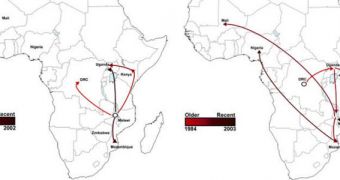According to a team of experts at the Wellcome Trust Sanger Institute, a bacteria that causes the disease non-Typhoidal Salmonella (iNTS) was allowed to spread through sub-Saharan Africa by the ever-growing HIV/AIDS pandemic.
The bacteria was able to acquire a series of genes that enable it to remain invulnerable to many of the front line drugs used to address it. What's worse, the condition it causes has a very high mortality rate, of around 45 percent (nearly 1 in 2 people in affects).
The new form of the bacteria Salmonella Typhimurium originated in two different spots, in southern and central Africa, around 52 and 35 years ago, respectively. Its history is detailed in a paper published on September 30.
“The immune system susceptibility provided by HIV, malaria and malnutrition at a young age, may provide a population in sub-Saharan Africa that is large enough for this detrimental pathogen to enter, adapt, circulate and thrive,” the team says, quoted by Science Daily.

 14 DAY TRIAL //
14 DAY TRIAL //